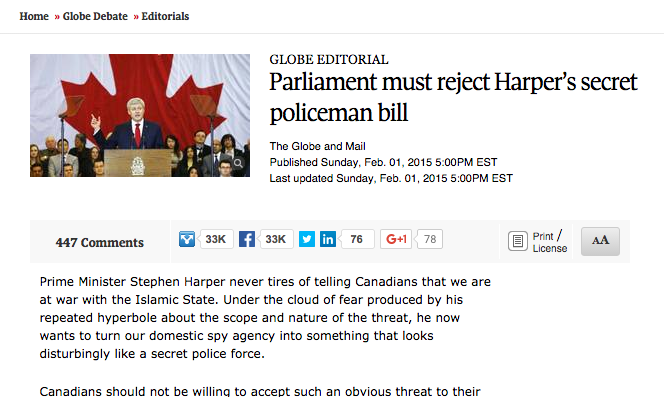Canadian news outlets were “equal to the challenge” of scrutinizing controversial Bill C-51, according to new research.
By Ilina Ghosh, for the Ryerson Journalism Research Center
A year ago this month, Canada’s new anti-terrorism legislation, the controversial Bill C-51, was unveiled at a campaign-style rally in a Toronto suburb. The divisive legislation initially encountered little opposition on Parliament Hill, leaving it to the media to highlight concerns.
And Canadian news outlets were “equal to the challenge,” according to new research conducted by Ryerson University School of Journalism instructor Kevin MacLean.
“For the first two and half to three weeks there was no opposition,” MacLean said.
“The NDP was quiet, refusing to take a position. The Liberals said they [were going to support it, but fix it…]. There was no one to oppose it politically, other than Elizabeth May, who got very little ink about what she had to say. There was nobody speaking out about it, other than the media.”
The bill, which became law in June, came under fire for the expanded powers it gives police and the Canadian Security Intelligence Service, its vague wording, its broad inter-agency information sharing provisions, its lack of security agency oversight and its potential to violate privacy and constitutional rights.
Unwilling to seem soft on terror the opposition parties initially sought the most “politically palatable” stance on the issue, says MacLean, and that resulted in a vacuum that news media stepped in to fill.
“When the government and opposition parties… abdicated their leadership roles and opted for political expediency…, the Canadian media became the de facto official Opposition, asking the tough questions, demanding answers, and outlining potential problems with the government’s response and its anti-terror legislation,” MacLean wrote in his analysis.
MacLean’s research, conducted for his master’s of professional communications at Royal Roads University, examined 140 news stories, columns, and editorials about Bill C-51 published in the National Post, the Globe and Mail and the Toronto Star in the four weeks after the bill’s unveiling on Jan. 30, 2015.
“It was not our political leadership’s finest hour, however, Canada’s media… showed their readiness to act as the conscience and voice of the nation when elected officials were unable and unwilling to do so,” he wrote.
Within days of Bill C-51’s unveiling, a Globe and Mail editorial referred to it as “Harper’s secret policeman bill” and outlined the legislation’s potential negative effects on Canadian democracy and security.
“Under the cloud of fear produced by [Harper’s] repeated hyperbole about the scope and nature of the threat, he now wants to turn our domestic spy agency into something that looks disturbingly like a secret police force,” the editorial began.
Concerns emerged related to the way the bill was unveiled and subsequently passed with limited debate.
“The Star and to some degree the Globe were extremely vocal in their opposition to C-51, [not only against the content of the bill], but the way it was done,” MacLean said in an interview with the RJRC.
“From the day it was introduced in a community centre in Richmond Hill, instead of Parliament, it was at a partisan political rally, which set the tone – it was like a pre-election campaign stop.”
Continue reading this story on the Ryerson Journalism Research Centre website.
Update: This text has been updated to clarify the lede.

